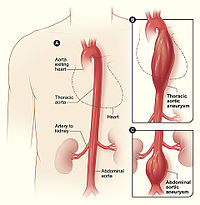
Photo from wikipedia
OBJECTIVE Management of anti-thrombotic therapy with warfarin in patients undergoing fistulograms and possible interventions is controversial and difficult due to lack of adequate outpatient bridging options. Our goal was to… Click to show full abstract
OBJECTIVE Management of anti-thrombotic therapy with warfarin in patients undergoing fistulograms and possible interventions is controversial and difficult due to lack of adequate outpatient bridging options. Our goal was to assess peri-procedural outcomes in patients managed using different anticoagulation strategies. METHODS A retrospective, single-institution analysis of all patients on chronic anticoagulation with warfarin undergoing fistulograms from 2011 to 2017 was performed. Anticoagulation management strategies were classified as suspended warfarin (SW), continued warfarin (CW), and heparin bridge with suspended warfarin (HB). Peri-procedural outcomes were analyzed. RESULTS There were 87 patients on chronic anticoagulation with warfarin who underwent 175 fistulograms. Median age was 63 years and 43.4% were female. Indications for warfarin included atrial fibrillation (53%), prior pulmonary embolism/deep vein thrombosis (29%), and hypercoagulable state (14%). Distribution was SW (60%), CW (26%), and HB (14%). Approximately half (53%) were same-day procedures, 30% occurred during access-related admissions, and 14% were performed during non-access-related admissions. Common indications for a fistulogram included difficulty with dialysis (63.4%), access thrombosis (20.6%), and poor maturation (10.3%). Interventions included angioplasty (82.9%), thrombectomy/embolectomy (20.6%), and stenting (8.6%). Thirty-day outcomes for SW vs. CW vs. HB were similar for bleeding complications (5.7%, 6.5%, 8.3%, P=.89), systemic thrombotic complications (3.8%, 2.2%, 0%; P=.569), access re-thrombosis (7.6%, 13%, 12.5%; P=.517) and tunneled dialysis catheter placement (11.4%, 13%, 12.5%; P=.958). After excluding procedures performed during a non-access-related admission, length of stay (LOS) was highest among HB (9.6 ± 7.8 days) compared to SW (2.6 ± 5.9 days) and CW (1 ± 2.8 days), (P<.0001). CONCLUSIONS Continued warfarin therapy in patients undergoing fistulograms was not associated with increased morbidity and was associated with shorter LOS. Bridging with heparin is not associated with improved outcomes, warranting a thorough consideration of continuing warfarin is safe and may streamline preservation of dialysis accesses without significantly increasing resource utilization.
Journal Title: Annals of vascular surgery
Year Published: 2020
Link to full text (if available)
Share on Social Media: Sign Up to like & get
recommendations!